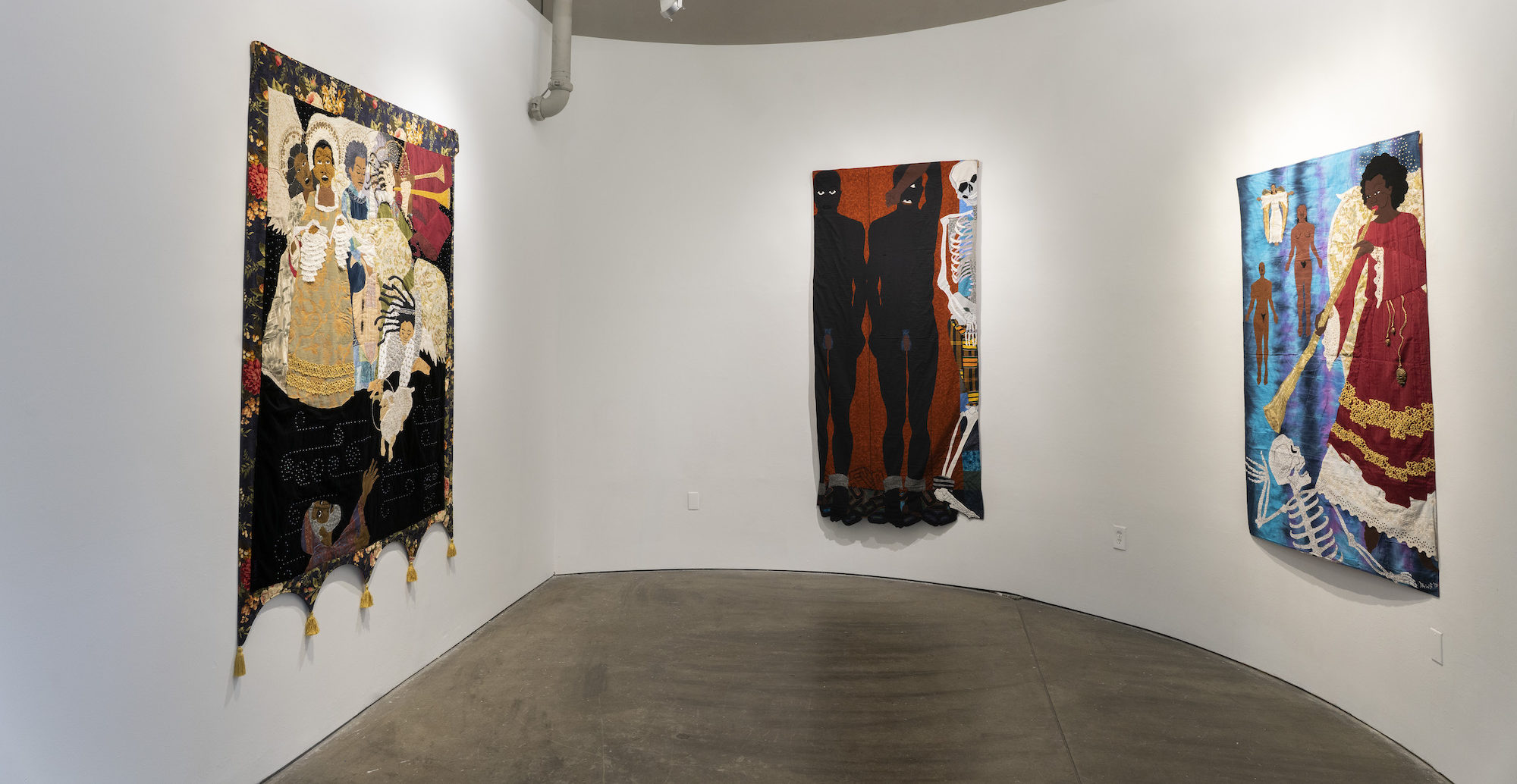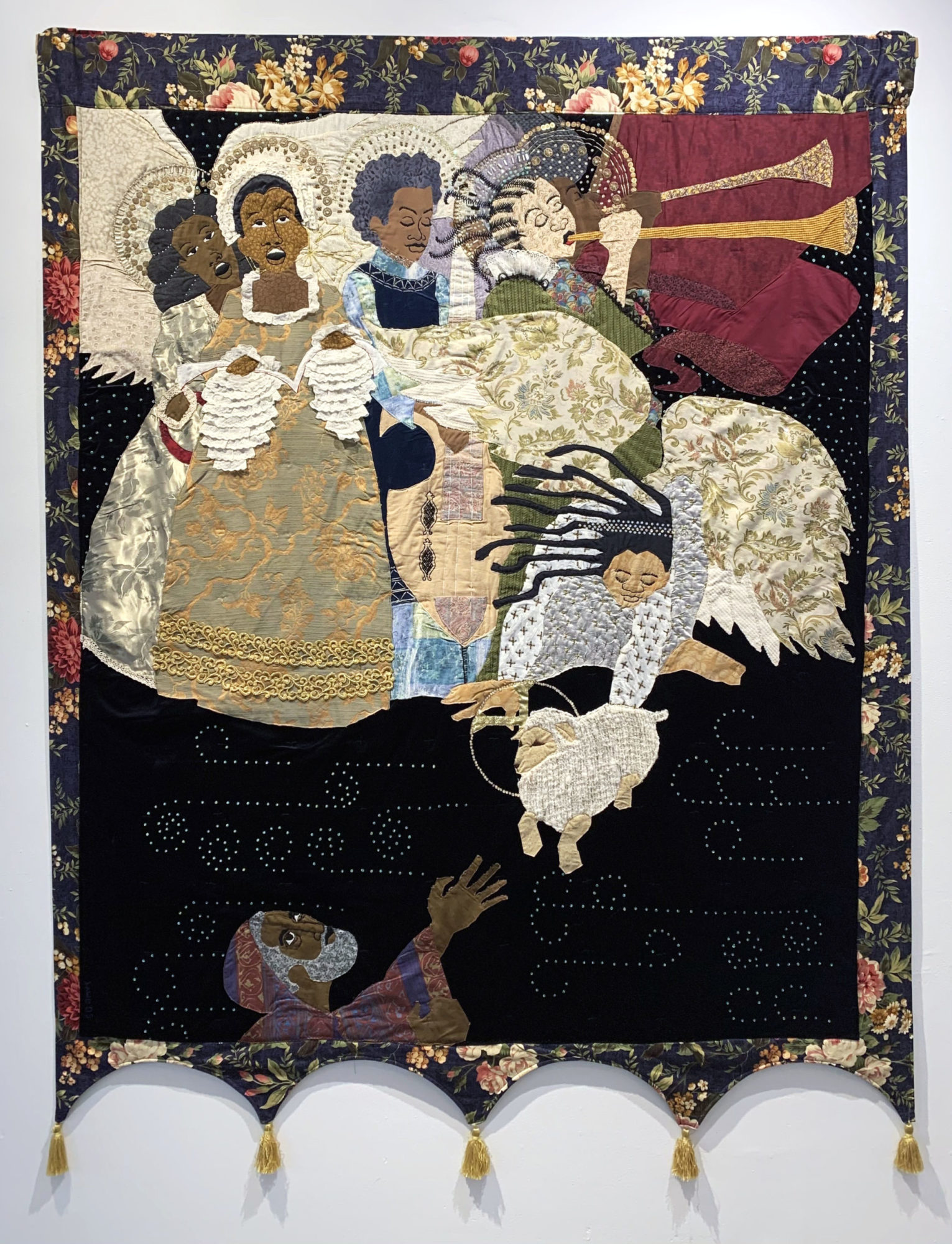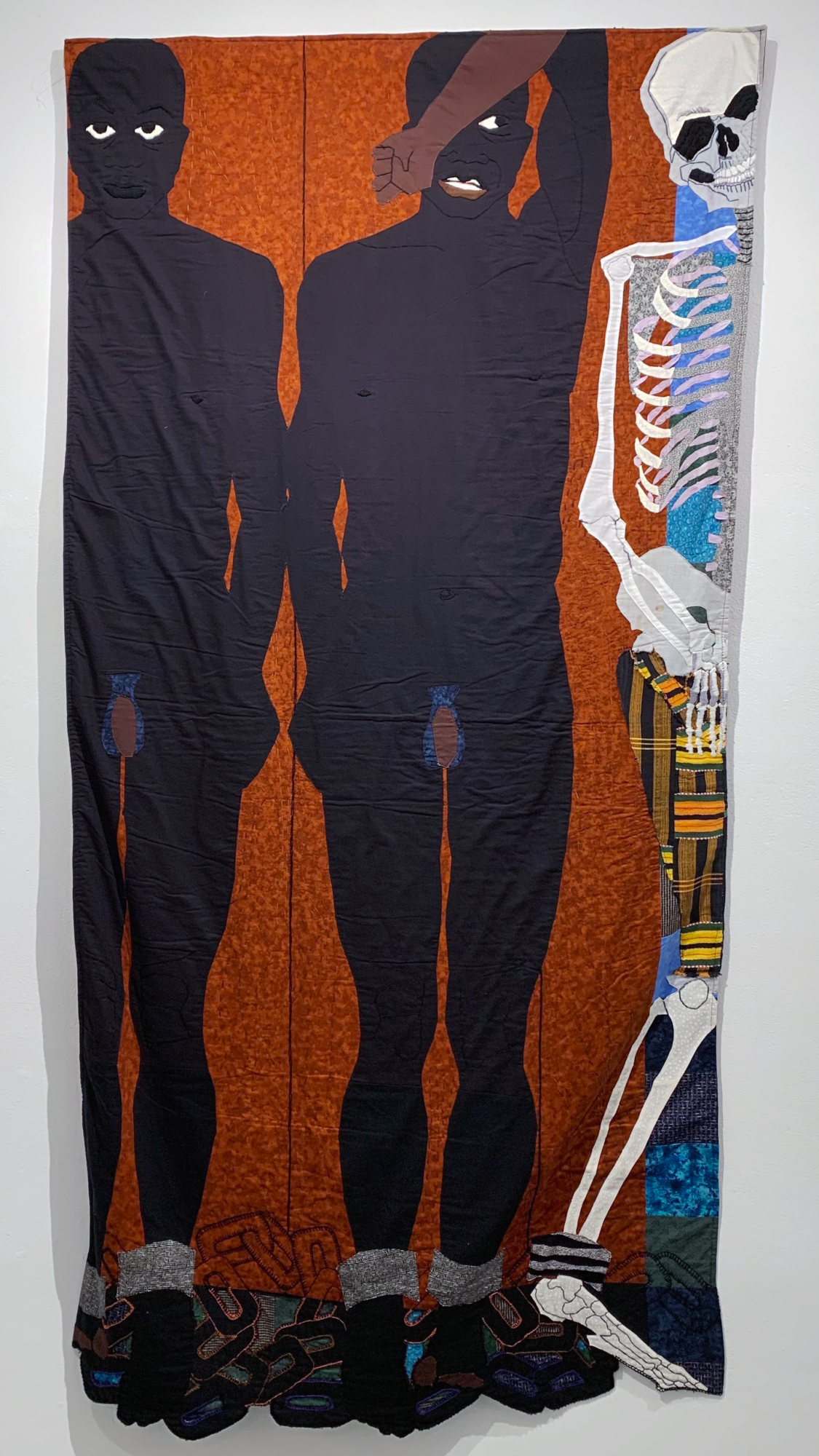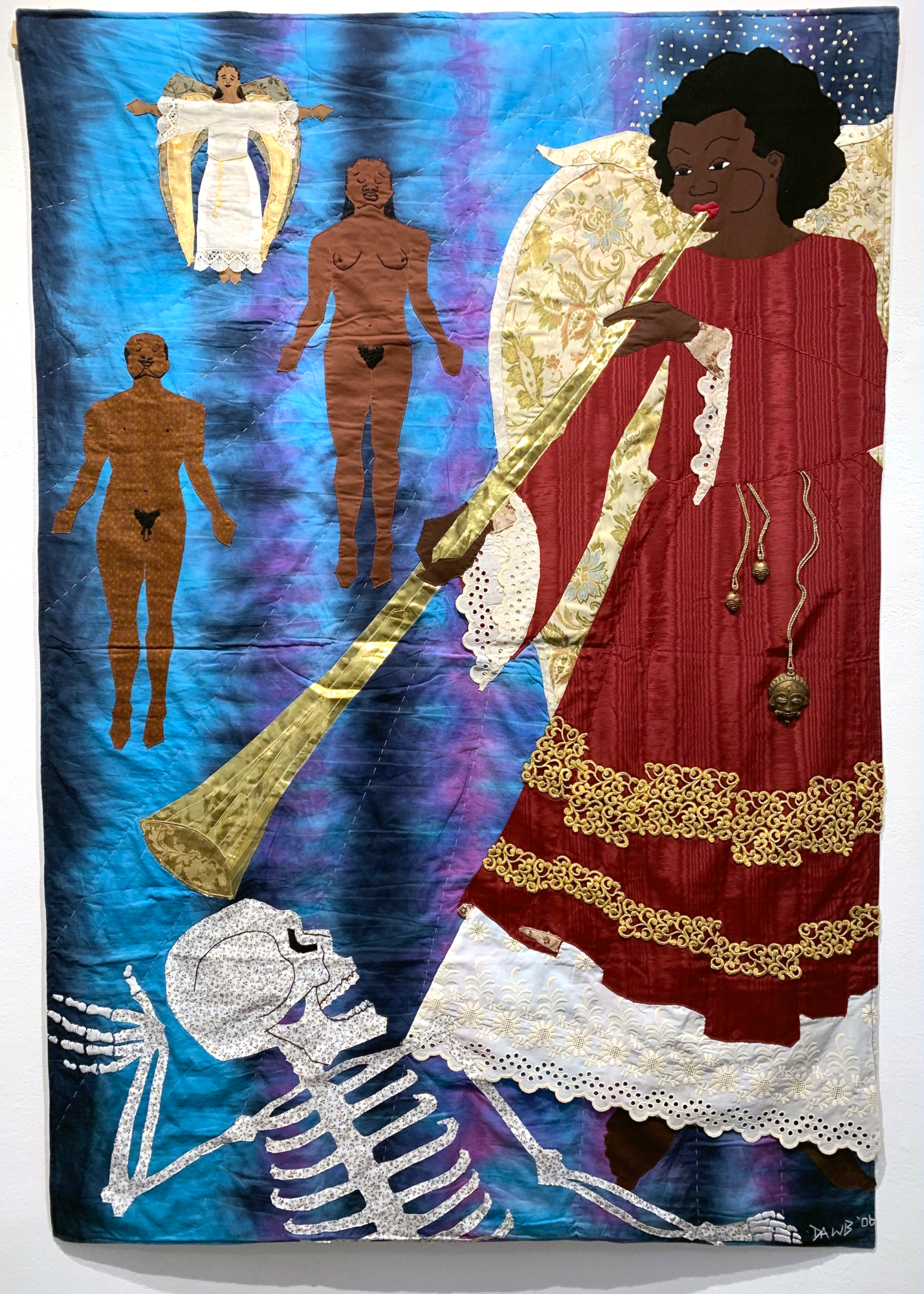Dawn Williams Boyd: Death Is Swallowed Up By Victory

Dawn Williams Boyd, “Death Is Swallowed Up By Victory,” 2020, installation view [photo: Amber Bernard; courtesy of Atlanta Contemporary]
Share:
The colossal “cloth paintings” of Dawn Williams Boyd, currently on view at Atlanta Contemporary, make a strong argument for in-person viewing—rather than from a glowing screen. When displayed in an Instagram post or installation view photo, they fall wildly flat in comparison to their corporeal counterparts, which fill the small alcove space with their scale, vibrancy, and powerful narrative.
On her website, Boyd acknowledges that her work has a quality which “just does not translate in pixels.” Certainly this limitation is due in part to their scale, but also to their rich variety of textures and intricate details. Boyd makes her cloth paintings from scraps of reused, recycled, and donated fabrics and materials. The result is a collage of laces, sequins, velvets, beads, jewels, ribbons, and more coalescing to form figurative and narrative works. Boyd uses the varying thickness and textures to her advantage. A lacy ruffle becomes an angel’s sleeve, black velvet becomes the inky night sky, thick wool becomes a lamb. This technique adds a three-dimensional element to the works and brings them to life.
Dawn Williams Boyd, “Hark, the Herald Angels Sing,” 2005, 83 x 65 inches, mixed media [photo: Ethan Cantrell; courtesy of Atlanta Contemporary]
Atlanta Contemporary boasts a sprawling, open main space for larger exhibitions, but it is also home to a handful of smaller exhibition spaces. These areas, often dedicated to guest curators or partnerships with other institutions, are tucked away in a basement or stairwell, or on a wall stretching between bathroom and gift shop. Although perhaps easily overlooked, these secondary spaces, on occasion, steal the show. Boyd’s exhibition lives in such a space, in an alcove to the right of the check-in desk, barely big enough for two people to stand six feet apart. Curated by Diana Settles of Hi-Lo Press, the exhibition features only three carefully selected works.
Through her work, Boyd is a storyteller: “I retell the history and culture of this country from the perspective of the ‘other’—the oppressed, the abused and the disenfranchised.” The story depicted in Death is Swallowed Up By Victory could be read as one of transformation and resurrection. The rounded walls of the alcove guide the viewer from one work to the next, starting with Hark! the Herald Angels Sing (2005)—a tale of birth, beginnings, and joy. In this cloth painting, each figure is frozen in mid-motion—two angels are singing, while three others form a small band, playing long trumpets and a lute. A sixth angel bends down, her long locks catching in the night’s breeze, the swirling motion reflecting the rolling sequined winds below. A mortal man reaches up toward her. The painstaking beadwork of the halos radiates around the angels’ heads, opulent and glittering.
Dawn Williams Boyd, “The Middle Passage,” 2007, 93 x 46 inches, mixed media [photo: Ethan Cantrell; courtesy of Atlanta Contemporary]
Dawn Williams Boyd, “I Corinthians 15: 51 – 54,” 2006, 68.5 x 47 inches, mixed media [photo: Ethan Cantrell; courtesy of Atlanta Contemporary]
At the center of this trio of works, The Middle Passage (2007) has a very different subject matter. The title refers to the notoriously brutal and horrific practice of the trans-Atlantic slave trade, wherein captured Africans were forced into densely packed ships and taken across the ocean. Two figures, naked except for chains, lie against a dark orange background. The third figure is a skeleton, which could be one of the two million people whose deaths were attributed directly to the conditions of the Middle Passage, but also seems to represent the symbolic presence of death. The Middle Passage avoids many of the lush, textural elements that adorn Boyd’s other two works here: no sequins or lace, no flourishing border of floral fabric, and hardly any implied movement. Notably, however, the skeleton lies against a sliver of blue checkered fabrics—a reference to Boyd’s reoccurring theme of life after death.
The third and final cloth painting completes the story. In 1 Corinthians 15:51–54 (2006), an angel, arms outstretched, leads two figures into the heavens, their ascending bodies accentuated by the blue and black lines of an otherworldly tie-dye backdrop. A skeleton reaches upward, much as does the man in Hark, the Herald Angels Sing, its bony form seeming to rise from the earth. Almost half the cloth painting is dominated, in its foreground, by an angel draped by heavy red fabric adorned with gold and jewels. This angel plays a long, golden horn pointed down at the specter of death, which appears to pursue the figures at bay. The dramatic composition of this work, as well as that in Hark, the Herald Angels Sing, points to Boyd’s early career as a painter and her influences from the High Renaissance and Baroque periods.
The bible verse in question—helpfully supplied by the wall text, and from which the exhibition takes its title—foretells a rapture: “For when the trumpet sounds, those who have died will be raised to live forever.” It’s the end of the story, but the positioning of the works in the circular space could also point toward a more cyclical narrative. After all, Boyd’s works are the sort that demand a second (and third, and fourth) look.
EC Flamming is a writer in Atlanta, GA. She has written for ART PAPERS, BURNAWAY, Another Gaze, Paste, and Arts ATL. Her quarantine activities include puzzling, doom scrolling, and banging her head against a wall.


